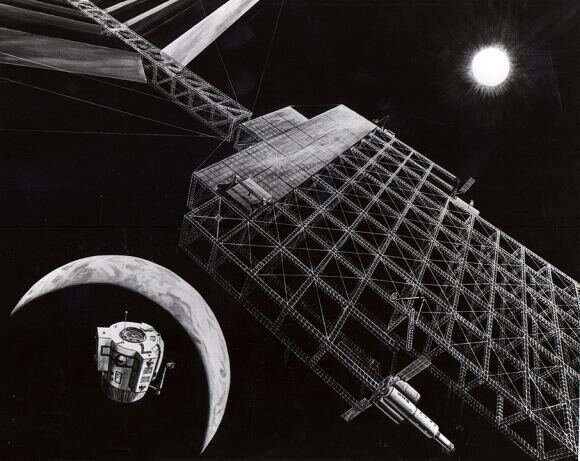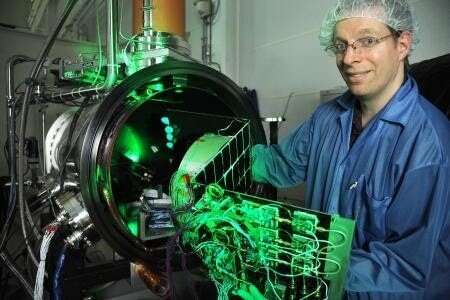The Navy is testing beaming solar power in space

Solar power has become a focal point of the battle to mitigate climate change. The potential of solar power is massive—Earth receives as much solar energy in an hour as all of humanity uses in a year. Even with that much energy hitting the Earth, it is only a tiny fraction of the sun's overall output. Some of that other solar energy hits other planets, but most is just lost to the void of deep space.
There are a number of groups that are leveraging various technologies to capture some of that lost energy. One of the most common technologies being pursued is the idea of the power satellite. Recently, one of those groups at America's Naval Research Laboratory (NRL) hit a milestone in the development of power satellite technology by launching their Photovoltaic RF Antenna Module (PRAM) test satellite.
The idea underlying power satellites is called "power beaming." power-beaming systems use one of three frequencies of light to transmit significant amounts of power over a distance wirelessly. Last year, NRL had a successful demonstration of a land-based power-beaming system using an infrared laser.
Doing it from space presents a whole new set of challenges though, and not necessarily just technical ones. Dr. Paul Jaffe, the technical lead on the PRAM project, described the process of being selected for an orbital launch as equivalent to Shark Tank—numerous PIs pitching their ideas for a trip to orbit. After several years of trying, PRAM finally got its time to shine on an X-37B launch on May 17th.
PRAM won't actually shine, though—it's surface is covered in black solar panels, and its innards consist of the first hardware ever launched to orbit that converts solar energy into microwaves. The satellite itself is relatively small (30 cm on a side), and won't actually be transmitting any power back to Earth. Instead, it will collect data that will serve as useful comparison points to an experiment using a similar system previously conducted back on Earth.
There were several metrics from the Earth-based test that the PRAM team were hoping to replicate in space. Efficiency of conversion from solar to microwave was one of the most important factors. Without high enough efficiency, future launches might be prohibitively expensive for the amount of power the system generates.
Thermal management is another extremely important measurement the team is looking forward to. On Earth, elaborate cooling systems are relatively simple to attach to a heat source. However, those methodologies don't work nearly as well in space, which can result in thermal management issues for any power electronics in orbit. The team hopes to achieve similar thermal management numbers to those seen on Earth from their radiative cooling system.
Both efficiency and thermal management go into the calculation of the most important parameter of power satellite systems—power density. If power is too concentrated, the system could potentially burn whatever it is pointed at. If it is too low, then not enough power is received at the base station to be useful in generating electricity.
Base station design is also a key factor in the long term success of power satellite technologies. Each frequency range would require a different style of base station. PRAM uses microwaves as its means of power transmission. Though most people commonly think of microwaves as a method for reheating leftover pizza, the signal frequencies for Bluetooth Low Energy and WiFi can also be considered in the spectrum of microwaves.
The level of illumination the system receives also has a major impact on the output power and thermal management. This is a data point that the team was unable to collect on Earth, and they are looking forward to getting data that shows the best illumination time for future missions. In geosynchronous orbit, a satellite can be in sunlight 99% of the time. However, there is a tradeoff between time in the sun and thermal management. The PRAM prototype was launched into an orbital configuration that will allow the team to calculate efficiencies, power densities and thermal loads of different illumination periods. The team will then use these data points to plan the optimal orbital path for further test launches.
The ultimate outcome of those further test launches would be a commercially viable solar satellite system that provides additional power to specific places on Earth with little to no additional cost once the satellite is in orbit. There are already numerous companies and research entities developing versions of power-beaming systems anxiously awaiting the outcome of the PRAM test.
Dr. Jaffe notes that the path to commercialization is based entirely on the resources assigned to the development of a commercially viable satellite. The time to a commercially viable power satellite could be relatively quick if provided with significant amounts of funding. On the other hand, the technology could die in its infancy if the money is pulled. It's still early days in the development of the technology, and the data PRAM is collecting is a necessary step in the derisking process needed for power satellites to become commercially viable.

One other step that has to happen for commercial viability is public acceptance. When mentioning the ideas of power satellites to most people, their immediate thoughts turn to Icarus, the fictional solar weapon in the James Bond movie "Die Another Day." In that movie, the satellite melts an ice hotel and shows its potential to destroy much larger parts of the world.
Dr. Jaffe is quick to point out the differences between PRAM and Icarus. Icarus is what is known as a "directed energy platform," which the Navy is also working on, but uses different physics than the power-beaming system that constitutes PRAM. He also mentions that it would be exceptionally difficult to turn a power-beaming system into a weapon: "If you put a magnifying glass in front of your Wi-Fi router, it doesn't start melting anything."
While whatever scientists say might not assuage all public fears over such a system, the potential benefits of beaming energy might outweigh those fears. Much more work is required before companies start investing in giant rectenna farms to collect that otherwise wasted energy. But in the next few months, NRL hopes to collect some data with PRAM that will bring commercial power-beaming systems a few steps closer to reality.
Provided by Universe Today





















